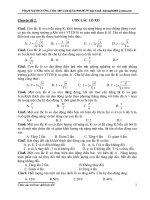Kendall7E ch14
Bạn đang xem bản rút gọn của tài liệu. Xem và tải ngay bản đầy đủ của tài liệu tại đây (2 MB, 64 trang )
Human Computer
Interface
Systems Analysis and Design,
7e
Kendall & Kendall
© 2008 Pearson Prentice Hall
14
Learning Objectives
• Understand human-computer interaction
• Know how fit affects performance and
well-being
• Understand the technology acceptance
model (TAM) and usability
• Know how to design for individuals and
persons with disabilities
• Understand the different types of, and
reasons for, using alternative user
interfaces
Kendall & Kendall
14-2
Learning Objectives
(Continued)
• Design effective dialog for HCI
• Understand the importance of user
feedback
• Articulate HCI implications for
designing ecommerce Web sites
• Formulate queries that permit
users to search the Web
Kendall & Kendall
14-3
Human-Computer
Interaction
• Awareness of HCI
• Attentiveness to issues of HCI
• Existence of HCI in organizational
settings
• Need to master the concepts
surrounding HCI
• Guidelines for usability
Kendall & Kendall
14-4
Major Topics
•
•
•
•
•
•
•
•
•
Understanding human-computer interaction
Fit
TAM
Designing for cognitive styles of individual
users
Physical considerations in HCI design
User interfaces
Dialog design
Feedback
Queries
Kendall & Kendall
14-5
Understanding HumanComputer Interaction
• Knowledge about the interplay
among users, tasks, task contexts,
IT, and the environments in which
the systems are used comprises
the basis of human-computer
interaction
Kendall & Kendall
14-6
Fit
• The “fit” between the HCI
elements of the human, the
computer, and the task that needs
to be performed leads to
performance and well-being
Kendall & Kendall
14-7
Figure 14.1 The “fit” among the human,
computer, and task affects performance
and well-being
Kendall & Kendall
14-8
Task
• Complex tasks that require human,
system, and task interaction are
supported by ecommerce and Web
systems, ERP systems, and wireless
systems inside and outside of the
organization
• Can be structured and routine or illdefined and without apparent structure
Kendall & Kendall
14-9
Performance
• A combination of the efficiency
involved in performing a task and
the quality of the work that is
produced by the task
Kendall & Kendall
14-10
Well-Being
• Concern for a human’s overall
comfort, safety, and health
• Psychological attitudes are also
important
Kendall & Kendall
14-11
The Technology Acceptance
Model (TAM) and Attitude
• A way for analysts to organize their
thinking about whether users will accept
and use information technology
• Can be used to shape training after a
system has been developed
• Can be used to garner user reactions to
prototypes
• Examines perceived usefulness and
perceived ease of use
Kendall & Kendall
14-12
The Technology Acceptance
Model (TAM) and Attitude
(Continued)
• Attitudes
• Satisfaction
• Anxiety
• Enjoyment
• Playfulness
Kendall & Kendall
14-13
Usability
• A way for designers to evaluate
the systems and interfaces they
create with an eye toward
addressing as many HCI concerns
as thoroughly possible
• Usability standards
• Usability heuristics
Kendall & Kendall
14-14
Designing for Cognitive Styles
of Individual Users
• Making sure data is made available
in different forms
• Tables
• Graphs
• Text
• Different times
Kendall & Kendall
14-15
Pivot Tables
• Allows a user to arrange data in a
table in any way they choose
• Gives users greater control over
how they look at data in different
ways within a table
Kendall & Kendall
14-16
Figure 14.3 A pivot table template can make it
easier for users to see information displayed in
different ways
Kendall & Kendall
14-17
Visual Analysis of
Databases
• Support visual thinking
• Extend the user’s cognitive
capabilities
• Increase the changes of making an
appropriate decision
Kendall & Kendall
14-18
Figure 14.7 When different graphs or tables can
be displayed on the same page, the page
resembles a dashboard. (Courtesy of
www.tableausoftware.com.)
Kendall & Kendall
14-19
Physical Considerations in HCI
Design
• Vision
• Hearing
• Touch
Kendall & Kendall
14-20









